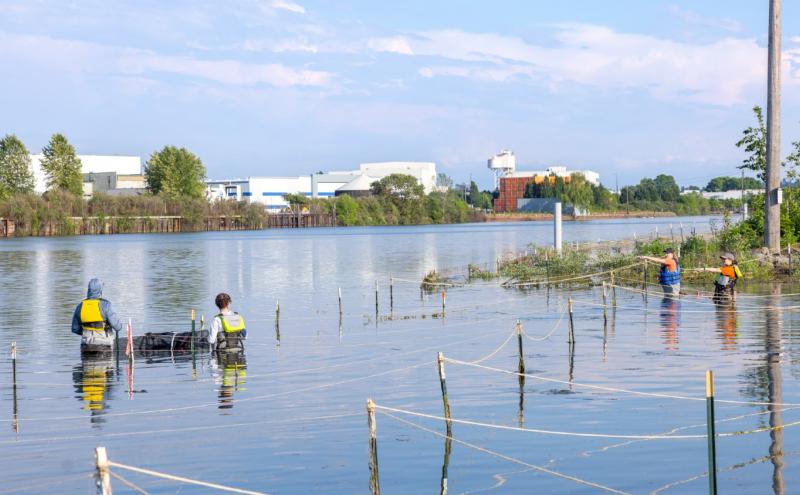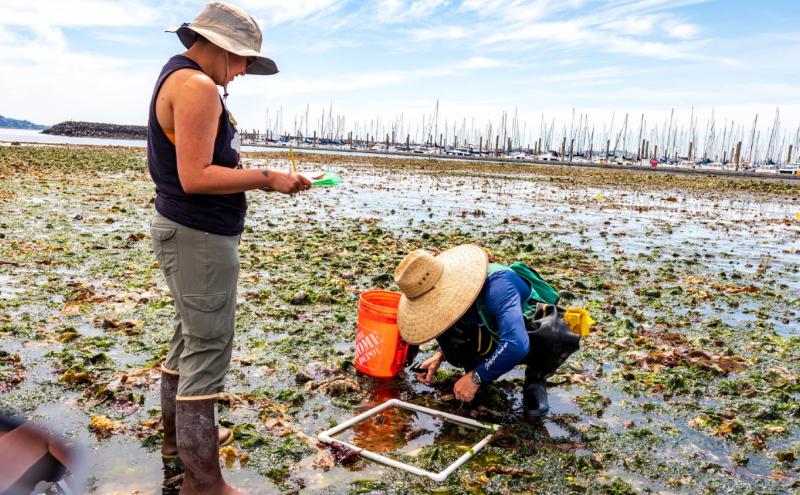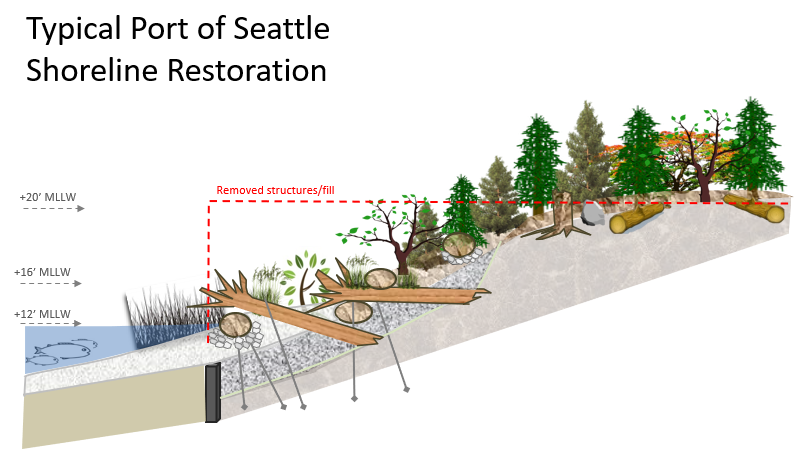

Building Sustainable Shorelines
Our region's aquatic environment, especially salmon habitat, is one of the Northwest's greatest resources. Around Puget Sound, several wild salmon runs have been protected under the Federal Endangered Species Act. Over 150 years ago, the Lower Duwamish River and estuarine area was 8.2 square miles of mudflat, marsh, forested wetland, and a river channel — an ideal home for fish and wildlife. Protecting, enhancing, and when possible, expanding this remaining habitat is crucial to fish and wildlife survival, especially as our region becomes increasingly urban.
When the Port of Seattle designs and constructs marine facilities, plans are implemented that avoid, minimize, and when appropriate, compensate for any anticipated effects on aquatic habitat.

The Port’s Sustainable Shorelines Program (SSP) is replacing hard shoreline armor — such as vertical bulkheads and rip-rap — with “greener” alternatives that improve water quality, increase carbon storage, and provide habitat for fish and wildlife. The program is also increasing the production of terrestrial and aquatic invertebrates (bugs!), which are a critical prey resource for young Chinook salmon.
Learn more about our Sustainable Shorelines Program.
As integral parts of major infrastructure projects, the Port of Seattle has:
- Restored or enhanced over 31 acres of fish and wildlife habitat at 16 sites throughout the Duwamish River, Elliott Bay, Puget Sound, and Lake Washington Ship Canal.
- Improved light penetration in shallow water areas by replacing solid piers with grated structures, removing overwater structures (Terminal 10, Terminal 5 Southeast, Terminal 25 South), and removing or reducing the number of pilings supporting docks. These close-to-shore waters are particularly crucial for juvenile salmon, as they allow them to migrate in areas inaccessible to large predators. These young salmon depend on the vegetation in these waters for food and protective cover and these plants need light to grow and thrive.
- Removed in-water barriers to migrating juvenile fish including a derelict ferry and sunken marina.
- Replaced more than 10,000 creosote (petroleum-treated) wooden pilings that contaminated fish habitats with fewer numbers of concrete and steel pilings. New, stronger pilings are installed with greater amounts of spacing, allowing more light to reach these under-pier waters.
Learn more about the Port's restoration efforts throughout the Lower Duwamish River.
Keeping a “Quiet Sound”
Underwater noise impacts orcas’ ability to hunt, communicate, navigate, and avoid danger. That noise in Puget Sound can come from a variety of sources, including (but not limited to) recreational boats, commercial vessels, and ferries.
To address this issue, the Port of Seattle partnered with the Port of Tacoma, the Northwest Seaport Alliance (NWSA), resource agencies, tribes, and non-profit organizations to develop the Quiet Sound Program. In addition to reducing underwater noise, the program is improving “real-time” systems for reporting whale sightings so that pilots of large commercial vessels can be alerted.
The Port is actively engaged in the Quiet Sound Program, participating in various committees, and working with our partners to improve the underwater acoustic landscape. The Port also promotes the voluntary vessel slowdown program.
Learn more about the Quiet Sound Program.
Learn more about the Port's involvement in the Quiet Sound Program and how you can report whale sightings through the Orca Network.
Learn more about the Port’s efforts to address ocean acidification.
Bull Kelp Research Partnership with the Seattle Aquarium
Bull kelp provides food and shelter for marine life, helps improve water quality, and stores carbon. Healthy kelp forests are a critical component of the Puget Sound and Salish Sea food web. Unfortunately, our region has seen a sharp decline in kelp forests.
To better understand this decline and how to help restore bull kelp forests, the Port of Seattle and the Seattle Aquarium have partnered to use an underwater drone, also known as ROV Nereo, to take a closer look. Our researchers hope that more detailed study will help us better understand how to conserve, protect, and restore vital kelp forests at the Port of Seattle and across Puget Sound.
Learn more about this research partnership.
Habitat Mitigation Banking
As a committed steward of the region’s public resources and the environment, the Port of Seattle launched a multi-site mitigation bank program to restore nearshore and wetland habitat in the Green-Duwamish River. This area is critical to our region’s salmon recovery goals. Through the self-sustaining model of a habitat mitigation bank, the Port sells environmental credits to landowners and developers. The revenue generated from these credits helps fund new habitat projects.
The Port’s first credit-generating project is the Duwamish River People’s Park and Shoreline Habitat which opened in 2022.
One of the Port's key Century Agenda goals is to restore, create, and enhance 40 additional acres of Green-Duwamish habitat. With the creation of the Duwamish River People’s Park and subsequent restoration sites, the Port is making progress towards this ambitious goal. Reinvesting revenue from credit sales allows the Port to advance sustainability initiatives and form new partnerships with environmental leaders.
Learn more about the Port’s habitat mitigation banking efforts.
Community Engagement
Recognizing that a healthy environment is vital for both the Port and surrounding communities, the Port of Seattle prioritizes collaborative environmental stewardship. Through education and outreach programs, the Port empowers near-Port residents and regional communities to participate in decision-making and advocate for environmental well-being. This commitment to community engagement fosters trust, empowers informed decision-making, and harnesses the power of collective action for a more sustainable future.
In 2024, the Maritime Habitat team held 22 stewardship events and 23 outreach events. In the past, we have also offered tours of the Duwamish River People’s Park and Shoreline Habitat for a variety of audiences and harbor cruises and Duwamish River boat tours to highlight the Port’s environmental efforts.

